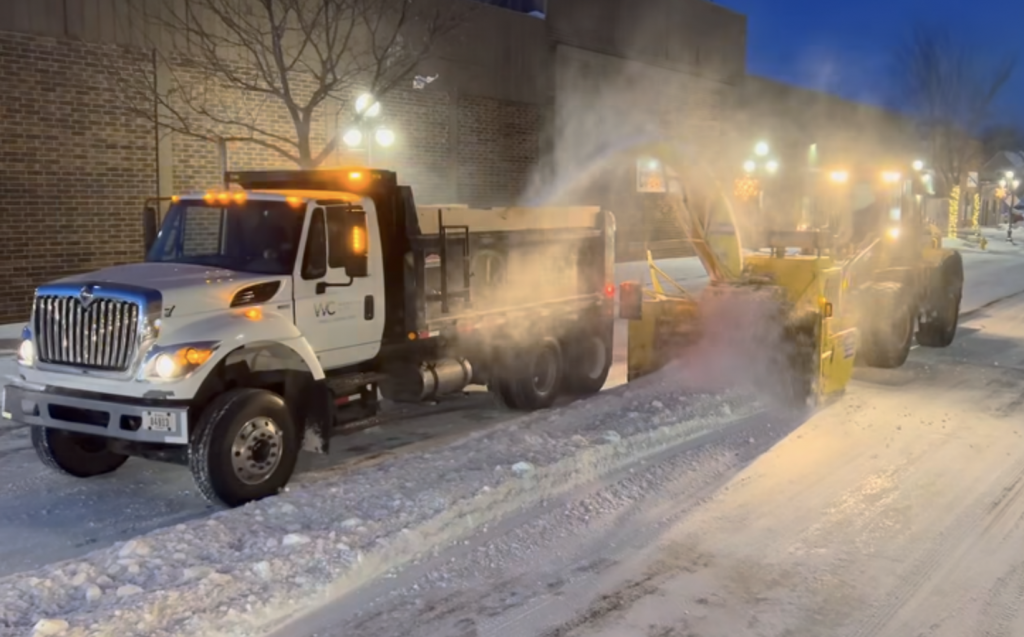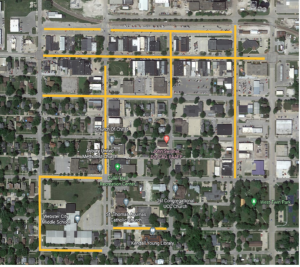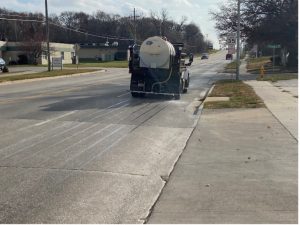Snow and Ice Removal
The Street Department is responsible for plowing and treating all City streets, 12 cul-de-sacs, alleys, and eight (8) City parking lots.
Maintaining safe winter driving conditions on all City streets is our number one priority.
Staff pays close attention to weather forecasts, monitors pavement surface temps, and utilizes pre-treatment applications to ensure the safety of our citizens. Living in Iowa, we all know how unpredictable our weather can be and because of that each snow event is handled on a case-by-case basis.
We recommend during any snow or ice event, everyone stays PATIENT, SAFE, and HAS A PLAN.

Snow Removal at a Glance
• Salt Brine is applied 24-hours prior to a snow event to prevent the bond.
• Plowing begins on all main arterial streets when snow accumulation creates slick and hazardous conditions.
• City-wide snow removal will take place when snow accumulations reach two (2) inches as measured by Street Department.
• Salt or Sand will be spread when City determines the streets are slick or in hazardous condition. Hills, bridges, curves, and main arterial streets and intersections are highest of priority.
• During a snow event, City plows will focus on main arterial streets and intersections and leave residential streets until snow has stopped.
• After a snow event all Commercial and Downtown business District streets will be cleared and treated by 7 AM.
• During a typical snowfall event, streets are cleared, treated, and snow is hauled away by 11 AM.

• Two (2) Snow Plow Trucks with Salt Spreaders (Commercial and Residential Routes)
• One (1) Snow Plow Truck w/out Spreader (Commercial and Residential Routes, Haul snow from windows and City Parking Lots)
• Two (2) Graders (Commercial and Residential Routes)
• Two (2) Payloaders with Plow (Downtown Window Areas, City Parking Lots, Cul-de-sacs, alleys, and more)
• One (1) Diesel Powered Snow Blower (Downtown Business District and School Zone windrows)
• Three (3) Dump Trucks used to Haul Snow from Windows and Parking Lots (Haul snow from windows and City parking lots)
 The City plows and treats public streets in the following order:
The City plows and treats public streets in the following order:
• Arterial Streets
• Schools Zones (windows)
• Downtown Business District (windows)
• Residential Streets
• City Parking Lots
• Cul-de-sacs
Exceptions may be made based on emergencies and storm impact.

Anti-icing Application  Anti-icing streets with a liquid solution of salt brine prior to a winter snow or ice event is a proactive approach used by staff. Anti-icing involves placing a layer of brine on the pavement surface before a winter snow or ice event to prevent snow or ice from freezing to the road. This process avoids snow and ice from bonding to the surface allowing snow plows to clear the roads and not leaving compacted snow. Anti-icings proactive approaches use one-quarter as much salt as deicing (re-active approach).
Anti-icing streets with a liquid solution of salt brine prior to a winter snow or ice event is a proactive approach used by staff. Anti-icing involves placing a layer of brine on the pavement surface before a winter snow or ice event to prevent snow or ice from freezing to the road. This process avoids snow and ice from bonding to the surface allowing snow plows to clear the roads and not leaving compacted snow. Anti-icings proactive approaches use one-quarter as much salt as deicing (re-active approach).
Street Department staff applies anti-icing solution to major arterial streets, hill, curves, and school zones. Factors that need to be considered prior to applying anti-icing solution include air temperature, wind speed, forecast, pavement temperatures and conditions.
De-icing Application
De-icing streets is a reactive approach where road salt treated with “beat” juice is applied to the road surface after plows have removed snow from the pavement. It is a reactive approach because treated salt is applied after a snow or ice event has started. Treated salt is spread on top of the compacted snow or ice and works from the top down to prevent the bond from the roadway. Operators are trained to “stitch the roadway” when applying treated rock salt. This means operators will spread salt at the beginning of a city block, middle and end. Traffic will then “track or drag” road salt as they travel down the road covering the entire road. De-icing methods using treated road salt is effective until temperatures dip below 10 degrees, at this point the effectiveness of road salt is reduced, and sand is applied for traction.
Sanding Application
Sand is spread on public streets when temperatures dip below freezing and/or high winds are forecasted. Sand also allows vehicles to get better traction on slick road ways and helps prevents the bond of additional snow or ice. The downfall to using sand on City streets is the negative impact it has on storm sewer infrastructure. Sand can easily stick to other debris in storm sewer mains and intakes creating a blockage or backup.
Sand application is also required on all new concrete street projects. Treated salt is not recommended on new concrete surfaces up to two (2) years.
Compacted Snow
The timing of each snow event has its impact on street conditions specifically when it comes to compacted snow. There are occasions plow operators cannot remove the snow off the roadway fast enough causing traffic to drive on it creating snow compaction. Snow removal procedures require plow operators off the road by 8 PM combined with vehicle traffic driving over the fresh snow creating snow compaction and slick conditions. When temperatures fall below freezing, de-icing applications have minimal effect on breaking through the bond. Increased temperatures and sun is the only chance crews have at successfully removing compacted snow.
Sec. 46-241. – When applicable
The provision of this division prohibiting the standing or parking of vehicles on designated streets or parts of streets during an emergency shall apply when an emergency declaration has been issued by the mayor, city manager, police chief, street superintendent or designee.
Sec. 46-242. – Declaration of emergency.
Whenever snow, freezing rain, sleet, snowdrifts or other natural phenomena create or are likely to create hazardous road conditions or road conditions impeding or likely to impede the free movement of fire, health, police, emergency or other vehicular traffic vital to the health, safety and welfare of the community, the mayor, city manager, police chief or street superintendent shall have the authority to declare an emergency when needed. In the absence of the mayor, city manager, police chief or street superintendent, designee shall have the authority to declare an emergency.
Sidewalks
Sec. 42-238. – Removal of snow, ice and accumulations
(a) It shall be the responsibility and duty of an abutting property owner or resident to remove snow, ice and accumulations from sidewalks within a reasonable time. Failure to perform shall be a simple misdemeanor.
(b) If an abutting property owner or resident fails to remove snow, ice or accumulations from sidewalks within a reasonable time, the city may do so and assess the costs against the property owner for collection in the same manner as a property tax.
(c)For the purposes of subsections (a) and (b) of this section, the term “resident” means the person renting, occupying or owning the abutting property. Proof of renting, occupying or ownership shall be determined by the name or names listed on the official billing records of the city utilities office on the date of the offense.
42-29. – Dumping of snow
It is unlawful for any person to throw, push, or place or cause to be thrown, pushed or placed, any ice or snow from private property, sidewalks, or driveways onto the traveled way of a street or alley so as to obstruct gutters, or impede the passage of vehicles upon the street or alley or to create a hazardous condition therein; except where, in the cleaning of large commercial drives in the business district it is absolutely necessary to move the snow onto the street or alley temporarily, such accumulation shall be removed promptly by the property owner or agent, and only after first making arrangements for such prompt removal at the owner’s cost of the accumulation within a reasonably short time.
Mailboxes
It is the homeowner’s responsibility to make sure the mailbox is accessible for the mail carrier/post office.
There are roughly 500 fire hydrants throughout the City of Webster City.
Never bury, block, or pile snow on or near a fire hydrant. Staff asks for your assistance in clearing a 3’ x 3’ area around the fire hydrant and path leading to the street.
Copyright ©2024 City of Webster City. All rights reserved. Website created by inTANDEM marketing.
